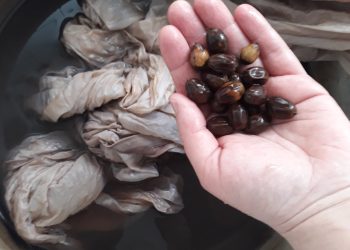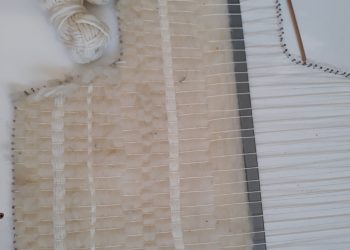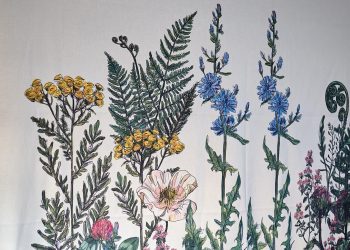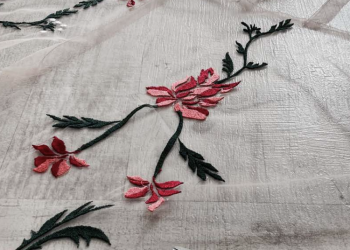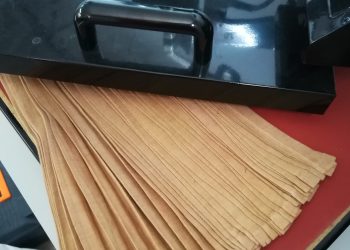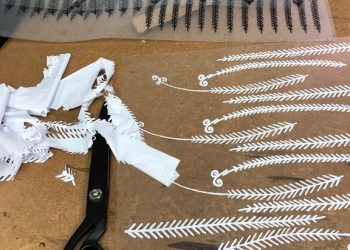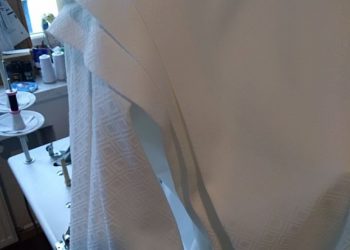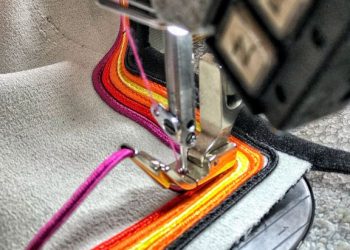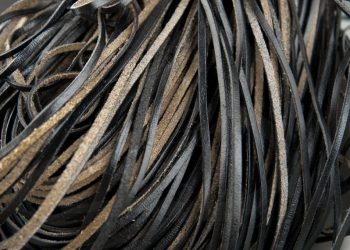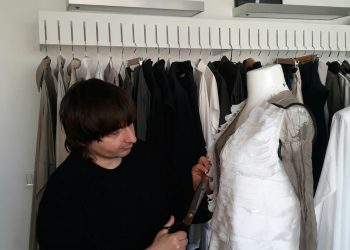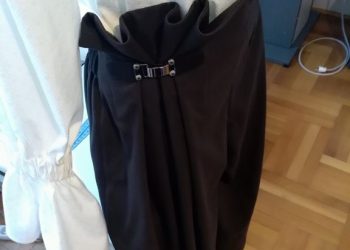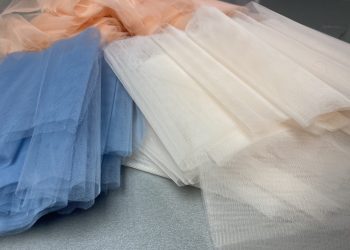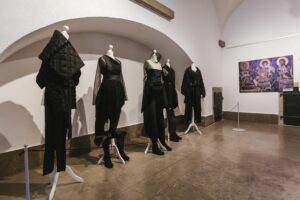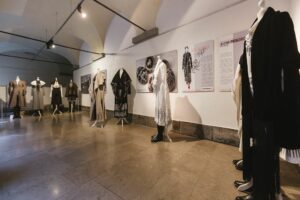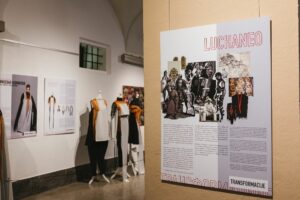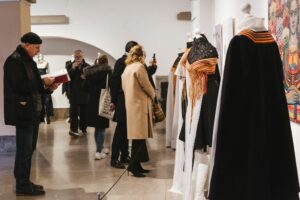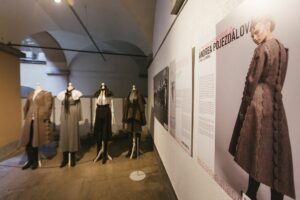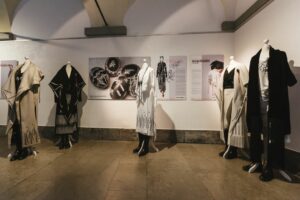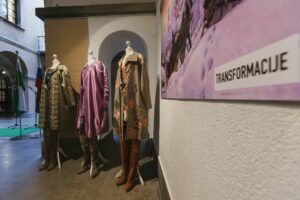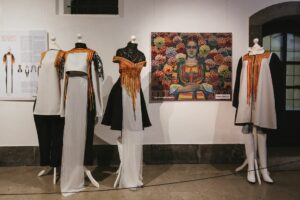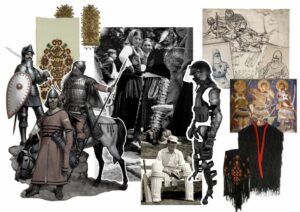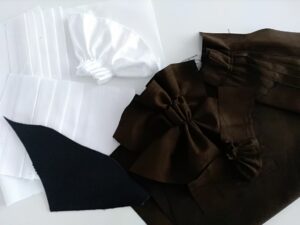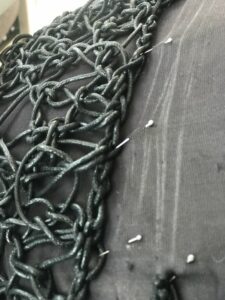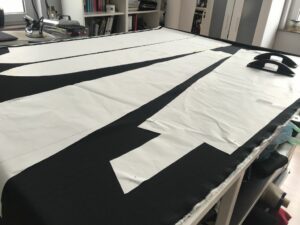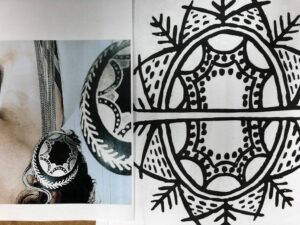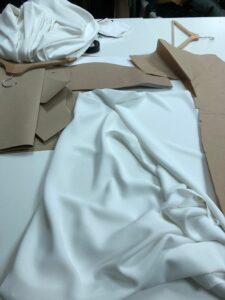Transformations
The clothing culture is vibrant and constantly changing. The project Transformations identifies the typical elements of the cultural heritage of Slavic nations in unique collections by flirting with esprit and specific sensibility of the fashion designers of the younger and middle generations.
FROM the Slavic Clothing Tradition TO Contemporary Designs
Transformations of Slavic heritage into 5 different modern design collections were created by:
- Nikolay Bozhilov/Bulgaria,
- Galina and Nikolay Biryukov/Russian Federation,
- Nevena Ivanović/Serbia,
- Andrea Pojezdálová/Slovakia,
- Jelena Proković/Slovenia,
- Denisa Dovalová/Czech Republic,
- Dragan Hristov/North Macedonia,
- Ivana Murišić/Montenegro,
- Jelena Holec/Croatia,
- Kinga Król/Poland.
“The dress is much more than what is visible at first glance. It is an expression of the individual, but also an important element of the collective identity and a witness of the social panorama of time and space. Economic, social, political and cultural conditions are reflected in the clothing culture. In selected materials, embroidered patterns, color palettes and garment cuts values, traditions and historical shifts are symbolically embodied.”
Slovanské Bohyně by Denisa Dovalová/Czech Republic
The main inspiration for Denisa Dovalová’s collection comes from the Slavic goddesses. Morana is a goddess associated with natural seasonal rites, the circle of life: birth,
death and rebirth. She decides when wintertime is over and she is also believed to be the goddess of sorcery and magic.
Mokosh, the goddess of Earth, is a patron of women. She protects women’s work and their destiny, and watches over them in childbirth. Her impact on the life of women was so strong that she became the Great Mother of Slavs, an iconic deity related to women around the world. Dodola is the goddess of rain, clouds and air, and the wife of the thunder god Perun. Živa is the goddess of life, offspring and fertility. Her name means “living, being, existing”. Lada is the goddess of love and beauty, also represented in the form of Freyja, Isis, Aphrodite, Venus and many others. She is portrayed as a young girl with long golden hair, sometimes with a wreath of wheat braided into her hair.
Calling her collection SLOVANSKÉ BOHYNĚ (Slavic Goddesses), Dovalová emphasises the importance of female presence in Slavic heritage. Their eminence can be seen through every detail of the outfits, from the use of old symbols as prints to the colour palette and silhouettes. Comfortable materials and stretch fabrics further accentuate their contemporaneity.
About DENISA DOVALOVÁ
Denisa Dovalová completed her master’s study in fashion design at the University of Tomas Bata in Zlín in 2015.
She built her skills as a designer also in the studio of the Dutch fashion designer Iris van Herpen, where she was a member of the Fédération de la Haute Couture. Since 2012, she has taken part in a number of international fashion events, such as Mercedes Benz Kiev Fashion Days, London-Paris-Kiev Fashion Scout Selection and the Mercedes Benz Fashion Week Central Europe in Budapest. In 2014, she was the winner of the talent contest Black Card Prague’s Unique Fashion Week. In 2016, she was a finalist of Designblok’s international Diploma Selection Competition.
In the same year, she established her own brand Denisa Dovala. In her design process, Dovalová seeks balance between ready-to-wear collections and independent creative fashion projects, through which she pursues her vision of integrating art in her creations. Each piece tells a story and the garments thus become interpreters of emotions, thoughts, and attitudes.
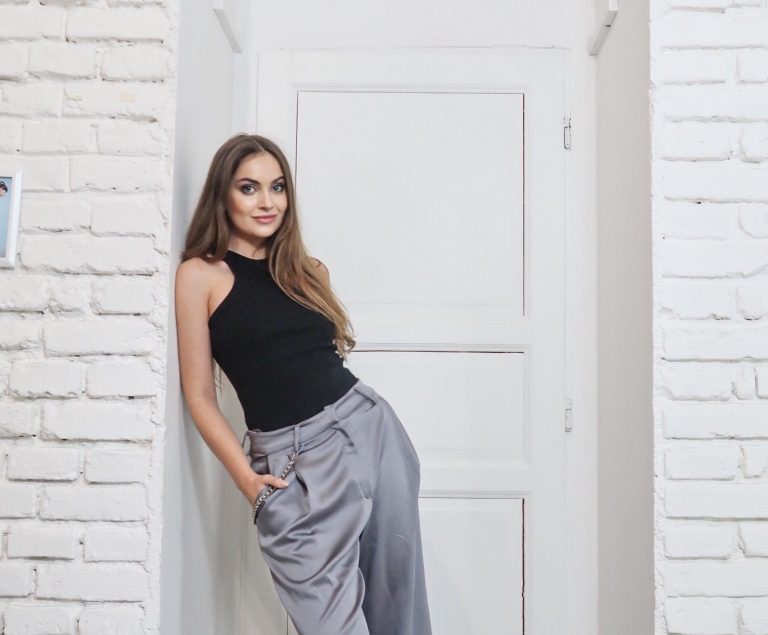
UKRAŠENA by Jelena Holec/Croatia
The UKRAŠENA (Ornamentation) collection by designer Jelena Holec is inspired by the people, customs, religion and life of the Croatian central region along the Sava River,
called Posavina. The designs are inspired by her exploration of richly pleated garments in red and white.
Born in this area, Holec was very lucky to have come across some original hundred-year-old hemp and jute fabrics. She decided to include them in the collection, thus emphasising the importance of Posavina’s textile heritage. Furthermore, this decision also sends a positive message about sustainable fashion and the importance of recycling old materials. New digital prints specially created for this collection are designed by multiplying forms that resemble traditional garment embroidery of geometric and floral patterns. The silhouettes are reminiscent of female figures of the time. The accentuated hips and shoulders highlight the role and position of women. They often covered their heads with head scarfs as a sign of their marital status. In the collection, this headpiece is used as a modern accessory. The deconstruction of traditional draping techniques is also strongly represented. Skirts are richly layered, employing a palette of intricate constructional historical details.
The entire collection is imbued with contrasting concepts: digitally printed futuristic fabric is juxtaposed with the traditional hemp textile, the naturally dyed fabric with modern printing methods, and carefully made hand-pleated skirts stand in opposition with huge asymmetrically draped parts. Light amber tones permeate the collection. The onion-dyed fabric symbolises the local rituals and customs, as the local people’s lives were defined by nature’s cycles and strongly connected to poor living conditions.
About JELENA HOLEC
Jelena Holec studied fashion design at the Faculty of Textile Technology in Zagreb. Having completed her master’s degree in 2015 she established her own fashion label Yelena H.
During her studies she presented her textile and fashion design work at numerous exhibitions and competitions. In 2014, she won the Portanova Fashion Incubator Award. Her work was presented at the Zagreb Fashion Week for three years in a row. She showed her designs at the International Croatian Design Festival D Day and the Croatian Design Week 15/16, and took part in the Competition for Young Fashion Designers Habitus Baltija in Riga, Latvia. In 2015, her rain jacket project “3 in a Bundle” was chosen for the regional talent platform Young Balkan Designers.
Intriguing with fascinating digital prints, her work is often featured in product presentations and promotions of new projects. Her textile design style combines photography, graphics, and drawing, resulting in colourful and futuristic creations, with a focus on crafting female garments that highlight the natural silhouette of the body.
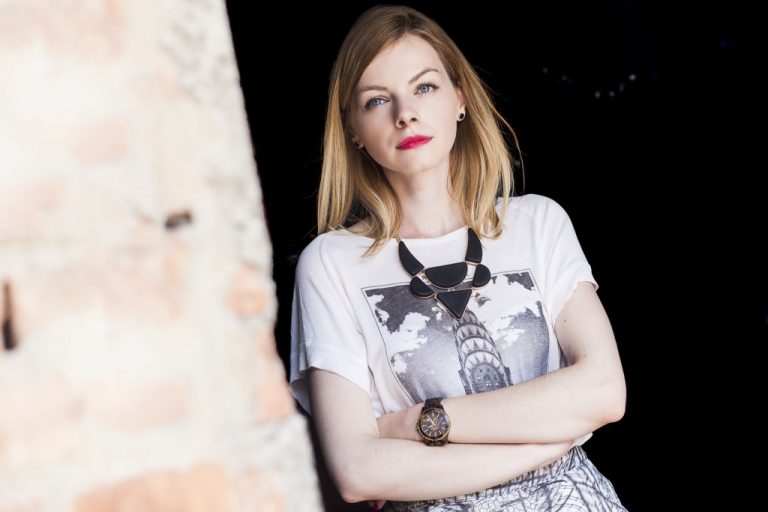
GORA by DRAGAN HRISTOV/NORTH MACEDONIA
The Slavs believed in water spirits and deities to whom they offered sacrifices, so one of the main inspirations for this collection is water, which is considered the source of life. The souls of the deceased were said to continue to live in water, and access to them was provided by the rivers.
Other earthly elements associated with the dead were stones and rocks, which were used to build places of worship, shrines and thrones. These were carved and transformed into magical beings and animals, and their sites were used as places where sacred rituals were performed. An important symbol in Slavic spiritual life was wheat, which was attributed to thunder-god Perun and Živa, the goddess of birth and fertility. Oak was believed to be the sacred tree of Perun. To reflect this, the fabrics for one of the outfits in the collection were hand-dyed with acorns. In addition to the natural elements, Hristov was strongly inspired also by the tradition of Macedonian pagan costumes. Characters like Vasilichar, Djolomari, Mechkar and others still appear today all over North Macedonia and beyond for various winter carnivals.
The GORA (Forest) collection is inspired by the deep respect that Slavic people had for nature. Hristov’s collection embodies the old Slavic spirit. The clothes are in light and neutral tones, the silhouettes are elongated and in the form of the already known constructions of the Ludus brand, this time designed to reflect the secrets of the Slavic forests. The collection is a set of contemporary clothing works of art, made from natural fibers, using
weaving, hand dyeing, crystallization, techniques that match the quality level of a museum exhibit.
About DRAGAN HRISTOV
Dragan Hristov established Ludus as a sustainable agender fashion label in 2010 in Skopje, North Macedonia, after his studies at Brera Academy of Fine Arts in Milan. His work is defined by two major interests developed during his life in Italy – fashion design and contemporary art.
With this label, Hristov participated at various international fashion events, fairs, festivals and exhibitions in Italy, Slovenia, Austria, Germany, the Netherlands, Poland, Bulgaria etc. He won the BIG SEE Fashion Design Award in 2018, NJAL+ Award at Assembly Designfestival in Graz in 2019, and WOW Show Award at the Ljubljana Fashion Week in 2020.
Conceptually driven, Hristov designs collections based on emotions, often melancholic and sad, constructing mostly monochromatic and minimal looks, and sculptural silhouettes that reflect the gender shifts in our societies today. Working exclusively with natural fabrics, he expands his sustainable efforts into natural dyeing with plants using different techniques, alongside local declining artisanal practices he transforms into contemporary products. Hristov’s aesthetic, which is unusual for the Balkan region, reflects his intimate relationship with nature and weaves a strong bond with Slavic heritage.
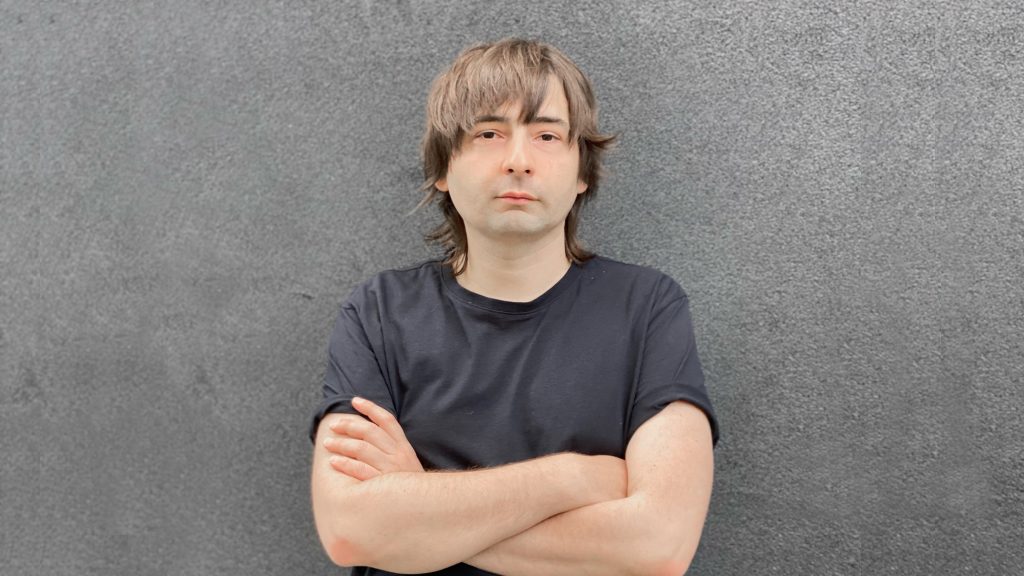
DZIWOżONA by KINGA KRÓL/POLAND
Kinga Król’s collection draws from the fascination of a nymph as a feminine icon, a figure who lives on her own terms as a wild woman. In Slavic etymology, „dziwo“ means god, sacred, wonder, and „żona“ stands for female, wife. If the name is taken literally, she becomes a wonder woman or strange wife. In other Slavic languages she is called
“diva lena” or “divá žena” and is known in folk tales of many countries in South-East Europe.
Dziwożona relates to a wild, independent woman. She lives the life of an outsider as she is a fairly dangerous creature that raises both fear and fascination. She is a nymph of swamps or forests, a spirit of a young woman who died suddenly before her marriage, during or after childbirth. She did not have the opportunity to fulfil her social role as a woman, so she seduces men and abducts other people’s babies to replace them with her own offsprings, called “foundlings” or “changelings”. At first, she is perceived as a young, beautiful girl but reveals a face of an old, unattractive woman when approached. So now, in her afterlife, she suffers as a female demon. According to folk belief, only herbs can protect us from her visits and spells.
Król’s collection DZIWOżONA (Wild Woman) revolves around three intertwining elements: patterns, cuts and textures. The printed patterns are based on various hand-drawn herbs, which were used in the past as protection against evil eyes and evil itself. The pleats are a contemporary interpretation of festive, woolen, often very colourful
folk pleated skirts. Dresses designed as oversized chemises reference traditional peasant clothes. The collection takes a contemporary and abstract approach to embroidery, a traditional technique of decorating clothes. Loose threads correspond with an aura of independence and primal connection with nature.
About KINGA KRÓL
Kinga Król graduated from the Secondary School of Fine Arts in Nałęczów, where she specialized in toy-making and puppetry. In 2002, she completed her master’s degree in Culture Science at the Faculty of Social Sciences at Adam Mickiéwicz University in Poznań.
In 1994, she worked on the stage design and production of the play Spring Festival at the Znak Theatre in Gdansk. She collaborated with the well-known Polish fashion brand Solar, working as the main designer between 2008 and 2010. Between 2016 and 2020, she gained experience as a teacher at the Fashion School in Poznan. Between 2018 and 2019 she also lectured at the School of Form in Poznan. In her career, she has collaborated with different clothing brands and companies (Aryton, Vito Vergelis, Semper …).
In 2011, Król launched her brand Confashion, which designs unique garments for women. Her signature style is always evolving. She creates her own fabrics, because she believes that each piece of her collection deserves to be perfect. In her effort to rebel unification in life and fashion, she has taken her collections to Kiev, Berlin, New York, Copenhagen, Paris and Harbin. With the Confashion brand she also took part in Textura – Polish Design Exhibition during London Design Week.
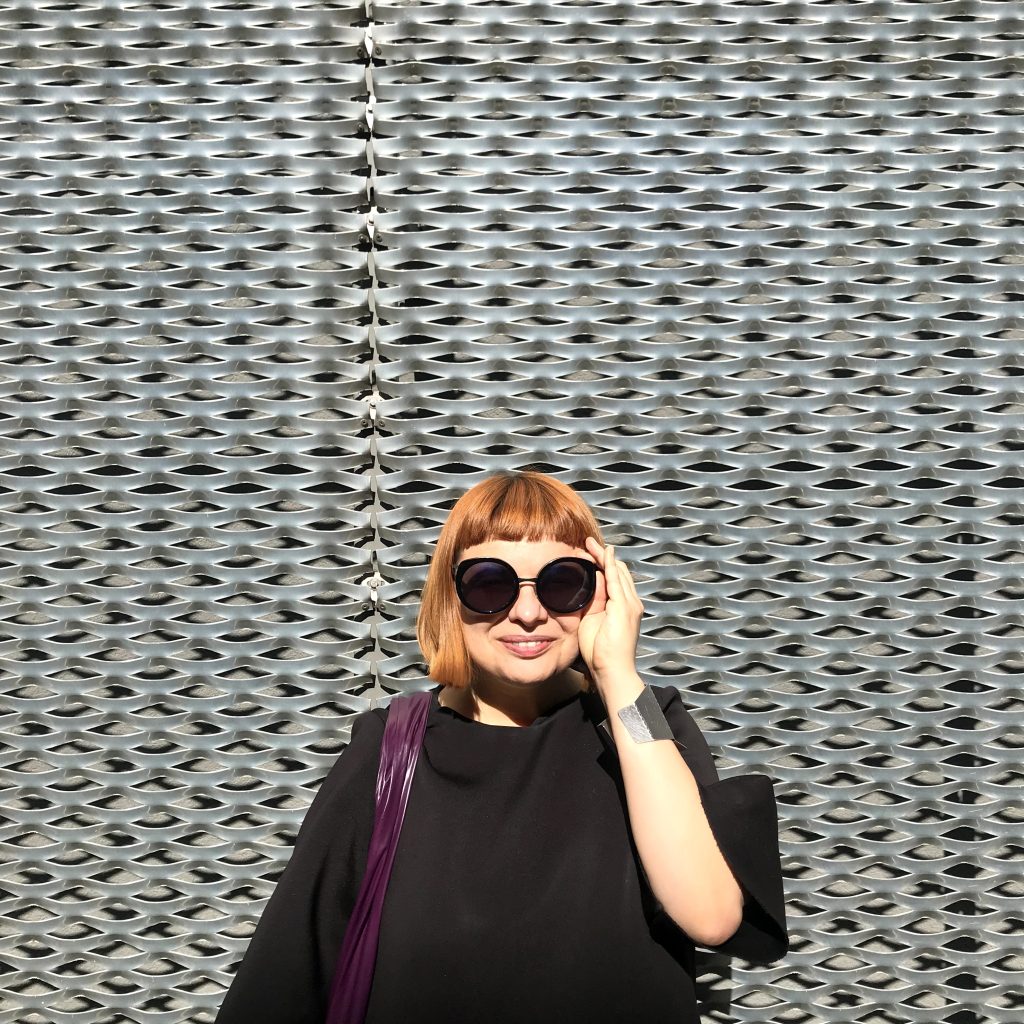
SLOBODA by Ivana Murišić/MONTENEGRO
Ivana Murišić’s creative process began in the spirit of winter melancholy, which became claustrophobic when the pandemic hit home. It was as if you could feel
the presence of Morana, the goddess of winter, all over the place. Everyone was waiting impatiently for the spring goddess Vesna to come and bring freedom and joy. In this atmosphere it occurred to the designer that she should dedicate the collection, which she called SLOBODA (Freedom), to this Slavic goddess.
In Slavic mythology Vesna represents the goddess of youth and is associated with spring, warm weather and the renewal of nature. As one of the sunniest deities Vesna was also one of the most loved. People name their daughters Vesna, because they believe they will be as sunny as spring and as joyful as the goddess herself. Even today,
Montenegrin people still celebrate Vesna in a traditional celebration which they call “Cvijeti” (flower day). Vesna defeats Morana, reinstating her rule in nature. But her victory is never definitive, as the cycle of life and death is repeated every year. Vesna’s ties with people can be traced back to prayers and numerous rituals performed to chase away winter and death from their homes. It was believed that in winter Vesna restores her health and natural balance, and thus strengthens people’s minds and
hearts.
The designer paid tribute to Vesna with embroidered flower motifs as the leitmotif of the collection. Transparent materials (organdy and tulle) dominate the collection. Light colours are used to bring out the goddess’s character.
About IVANA MURIŠIĆ
Ivana Murišić studied stage and contemporary costume design at the Academy of Fine Arts in Belgrade, where she graduated in 2010 with her collection „Vajang Kulit“, which was presented at the Belgrade Fashion Week the same year.
In 2009, her fashion collection was a finalist in Grazia magazine’s competition for young talents and showcased at the Fashion Selection event in Belgrade. She was involved in a number of theatre and film projects, and in 2020, she participated as a costume designer in several projects organised by the Montenegrin Ministry of Culture. In January 2011, Ivana opened her design studio in the Belgrade Design District, and three years later she opened a studio in Podgorica. Her collections have been continuously featured at the Belgrade and Montenegro Fashion Weeks.
Her work is recognized for the many hours of handwork invested in her designs, creating embroideries that enrich the volume and emphasize the three-dimensionality of the clothes. She combines artificial materials with various natural fabrics (silk, leather, cotton etc.). Her sensual silhouettes exude femininity and a touch of glamour.
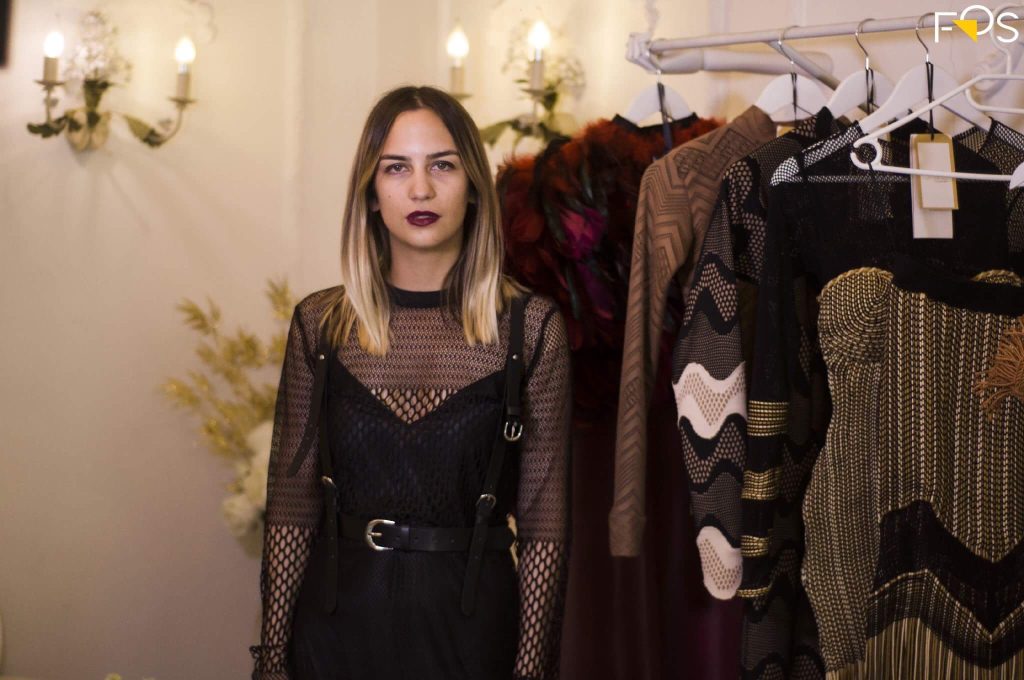
Spirit by Nikolay Bozhilov/Bulgaria
The collection’s primary inspiration is the “nestinarstvo” ritual, a barefoot dance on smouldering embers, protected by UNESCO as Bulgarian intangible cultural heritage. Believed to bring health and fertility the ritual takes place on St. Constantin and St. Helen’s Day on the 3) and 4 June in southeast Bulgaria. After the morning procession with participants carrying icons of both saints the festivities culminate in the evening with the “fire dance”.
Another source of Bozhilov’s inspiration was the characteristic element of the Bulgarian traditional dress, so-called gaytan, decorative braiding “framing” the beauty of Bulgarian women. The interlacing of threads in gaytan is very complex, and may use three to as many as twelve strands of different colours.
Bozhilov based each of his five “looks” on a distinctive item of Bulgarian traditional dress: women’s dress called saya, the traditional women’s litak, traditional men’s trousers potur, and men’s fabrics aba and yamorluk. The pinnacle of the collection is a hand-made gaytan arranged in a colourful composition that frames a woman’s face into exaggeratedly symmetrical proportions. Bozhilov also refined the silhouette, which is more basic and rough in its traditional folk version, so that it shines through the black and white palette in a completely new, elegant dimension. He also added very original, extended collars made of intertwined neoprene threads as the dominant fashion accessory.
The key reference of Spirit’s visual expression is the work of Vladimir Dimitrov – Maistora (1882-1960), one of Bulgaria’s most prominent artists. Maistora was the quintessential Bulgarian painter whose work captures the “Bulgarian spirit”. He dedicated his entire body of work to Bulgaria, its people, in the first place the commoners, its land, history, wars and battles, tradition, folklore, customs, natural beauties and women. Some call his “Bulgarian Madonna”, which depicts a girl from the village of Shishkovtzi, his Mona Lisa.
Spirit is not a collection that simply evokes vernacular mysticism and sublimates the traditional clothing culture. It is much more. It is Nikolay Bozhilov’s unique fashion monument to the painter who was fatally seduced by the fantasy of a perfect woman. The iconic “Bulgarian Madonna” has turned into a true fashion icon.
About Nikolay Bozhilov
Nikolay Bozhilov graduated in fashion from the National Academy of Arts in 2011 and completed his Master’s degree there two years later. In 2020, he completed his doctorate at the same academy.
In 2010, when still a student, he received the Golden Needle, a prestigious award conferred by the Bulgarian Fashion Academy. In 2011 his project Morphology won the International Triumph Inspiration Award at London’s Fashion Week. In 2013 he officially launched his own brand and received yet another Golden Needle in Sofia. The next year, he presented his collection Symbiosis at the Mercedes-Benz Fashion Week in Berlin. In 2020, his SPIRIT collection won the BIG SEE FASHION DESIGN award and in 2022 he was awarded One in 50 of 2022 certificate of achievement
from Kyoto Global Design Awards for the same collection.
Bozhilov works in the creative field of conceptual fashion, intensely focusing on experiments in fashion while trying to create new, timeless aesthetic standards by combining past paradigms with contemporary ones.
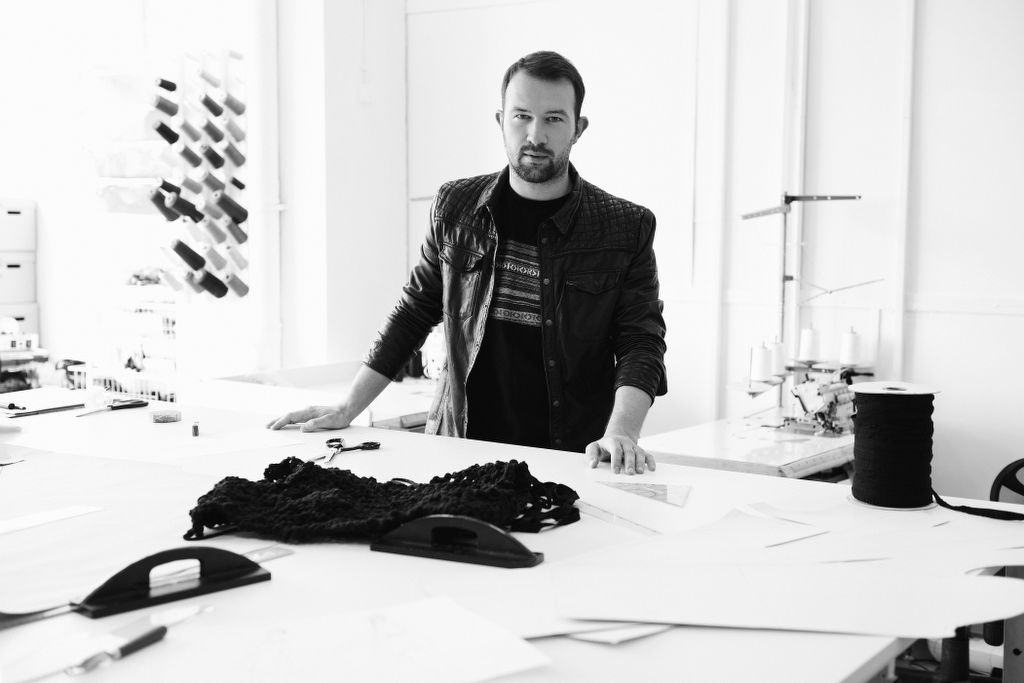
Silver Ring by Galina and Nikolay Biryukov/Russian Federation
Galina and Nikolay Biryukov called their collection the “Silver Ring of Russia”, after the Russian Federation’s new cross-regional initiative that sets out to establish the next grand historic, cultural and tourist route. The first being the famed “Golden Ring of Russia”, of course, spanning more than 700 kilometres of the circular theme route connecting old Russian cities with numerous architectural, religious and cultural sites to the northeast of Moscow.
Similarly, the Silver Ring connects cathedrals, churches, monasteries, palaces, gardens, fortresses and museums gravitating towards the northwest, where the magnificent St. Petersburg dominates over the River Neva and the Baltic Sea.
The Biryukovs use a stylised imperial crown as the leading decorative element of their collection. They had introduced the imperial crown motif, the most exclusive insignia of all Tzar’s regalia, already in their previous collections, e.g. in Top Secret (SS 2018) and Parfum (FW 2018-19), both presented at the Mercedes-Benz Fashion Week Russia. In this context, the Silver Ring takes up the thread of their fashion story.
Another echo or Russian history resonates in the collection’s carefully selected colour scale. It references Galina Biryukova’s roots, as she comes from the region where the iconic painter Dionysius created his famous monumental masterpiece in the early 16th century. The colour palette spanning gold and sky blue to purple and olive green shades deliberately references some of the painters of Russian symbolism.
The couple point out the in*uence of Mikhail Nesterov (1862-1942) and Boris Kustodiev (1878-1927). The latter was nicknamed the “Russian Rubens” for his fondness of depicting full-bodied women. Another source of inspiration for the designers was the work of Isaac Ilyich Levitan (1860-1900), one of the masters of Russian landscape painting.
The Silver Ring collection is a distillate of all of the above – the turbulent history, stunning architecture, breathtaking landscapes, art and religion, nostalgia and melancholy.
About Galina and Nikolay Biryukov
Galina Biryukova (1973) graduated from the Moscow Slava Zaitsev Fashion Laboratory led by Vyacheslav Mikhaylovich Zaitsev. In 2016 she received the Lamanova Prize for professional fashion designers. The prize is dedicated to Nadezhda Petrovna Lamanova, fashion and costume designer who had served as supplier of Her Majesty’s Imperial Court before the Russian Revolution and went on to lay the foundations for the new Soviet fashion afterwards.
Nikolay Biryukov is a painter, graphic artist, photographer and fashion designer as well as a graduate of the St. Petersburg School of Restoration, and once even served as a restoration specialist at the Hermitage Museum. In 1995 he graduated from the arts department at the state pedagogical university in St. Petersburg and later taught art history.
Couple Biryukov are the creators of the brand KGB (the initials stand for their names, Kolya Galya Biryukovy) which has so far presented nine collections, namely at the Mercedes-Benz Fashion Week in Moscow, Estet Fashion Week in Moscow, Fashion Week in Minsk, Belarus, and other fashion events. Since 2019, KGB has been the offcial brand of the agency Models Runway Italy from Milan.
Fascinated by the Russian symbolist movement Galina and Nikolay Biryukov with their KGB projects explore the possibilities of siting Russian history of art into a contemporary context.
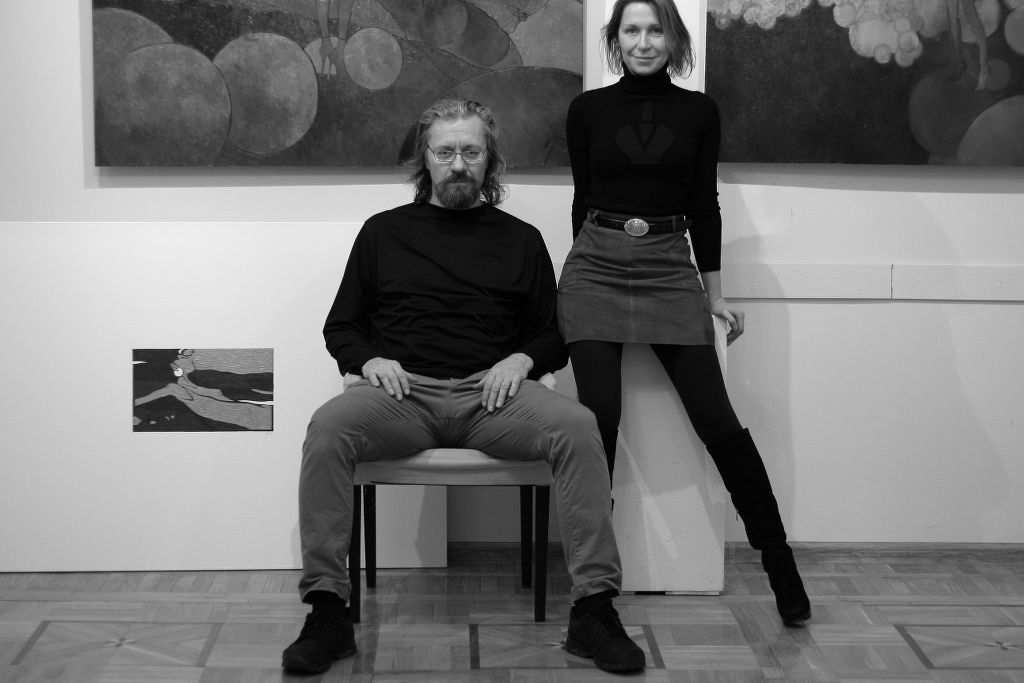
Luchaneo by Nevena Ivanović/Serbia
The Luchaneo collection was inspired by the phenomenon of medieval Serbian knights, who after all the centuries since their demise continue to inform Serbian national identity with their historical and mythic potency. Ivanovic juxtaposed the knights’ armours with modern-day “armours”, uniforms of those believed to be the patrons and protectors of the nation, striking a dialogue between them.
She applied the traditional-contemporary binary to sportswear and equipment as well as uniforms of special police and army forces, which include shields and other gear protecting the body from injury.
Looking back at the formidable knightly silhouette she discretely blended it with elements from Serbian folk costumes that come through in the dark blue jacket, wide waist and a corset, and created a contemporary collection whose narrative speaks to the modern, emancipated woman. The dialogue between history and contemporaneity is further accentuated with innovative use of modern artificial materials: polyester, plastic and synthetic leather. These put an edge on the “soft” side of the collection, which features pieces made of silk, viscose, cotton, wool and other natural materials.
Despotovac in central Serbia is the venue of “Just Out”, the largest medieval festival in Europe, which takes place in the Orthodox monastery Manasija from the early 15th century. This historic, ethnographic, educational, cultural and music festival brings together visitors who come from across Europe and beyond – Russia, Japan and even Iran and Africa – to immerse themselves in the medieval times. Naturally, the festival culminates in the knights’ tournament featuring realistically re-enacted fights between knights competing in various disciplines.
Luchaneo, a collection with exceptionally elaborated construction solutions, demonstrates that creative imagination can blend seemingly incompatible concepts, worlds and epochs. Nevena Ivanović has done it in a truly knightly manner – valiantly, honestly and to the highest creative standards.
About Nevena Ivanović
Nevena Ivanović completed her undergraduate studies at the French school of fashion and fashion management “Mod’Art International”. In 2016 she graduated at the Faculty of Arts and Design in Belgrade. She launched her own brand NEO design.
Her first solo fashion show was in Paris in 2016. In 2017, she won several prizes and awards, and was also selected as the best designer at Serbia Fashion Week. The Fashion Scout SEE prize, which she won the same year, came with a fully sponsored show at London Fashion Week. Later, she recieved a special Belgrade Fashion Week award for promoting Serbian National Heritage. In 2018 and 2019 she dressed the Serbian national representatives for the Eurovision Song Contest.
She is intrigued by Oriental, especially traditional Japanese culture, which inspired her graduation thesis, and also embraces African influences and, naturally, the bountiful heritage of the Balkans.

Retrotopia by Andrea Pojezdálová/Slovak Republic
Already at first sight, Andrea Pojezdálová’s Retrotopia collection exudes calm spirituality not unlike that which can be seen in Slovak sacred architecture, especially the typical wooden country churches. The author references these architectural gems protected by UNESCO and the traditional Slovak folk costumes as two of the conceptual baselines of her design.
But the collection could not have evolved the way it had if the designer hadn’t tapped into the impressive legacy of one of the most fascinating personalities of Slovak culture. Karol Plicka, Vienna-born Czech photographer, cinematographer, musician and folklorist was a renaissance man through and through. His photographic monograph Slovensko and poetic documentary Zem spieva, the holy grail of Slovak cinematography and ethnology depicting idyllic scenes of “unspoilt” life of organic rural community of the common people whom he follows in the entire “from sowing to the harvest” cycle, were the inexhaustible source for the Retrotopia collection.
With a carefully though-out colour scale Pojezdálová effectively (re)creates the characteristic romantic atmosphere that Plicka so subtly documented in his photographs and films. The garments of Retrotopia come in subdued shades of beige, brown and grey agitated by shiny white and black details. Predominantly natural materials, such as cotton, wool, felt and leather are combined with simple traditional dress-making techniques (folding, hemming, embroidery and decorations) and minimalist design that aptly translates nostalgia into a contemporary clothing paradigm.
Retrotopia is not her first utopia, though. In 2016 Pojezdálová participated in the International Fashion Showcase organised by the British Fashion Council in the framework of the London Fashion Week, marking the 500 years of publication of the most famous of utopias – Thomas More’s.
About Andrea Pojezdálová
Andrea Pojezdálová studied fashion design at the Academy of Fine Arts and Design, where she graduated in 2015 with her collection Back to the Roots, which won her the Best Fashion Graduate Award.
Her first breakthrough, however, came with her collection White four years prior and won her the title of Brilliance Fashion Talent for young designer of the year. The same year, in 2011, she won the International Re-act Fashion competition. In 2016 she returned to London with her collection Noir that won her the title Best Designer FL. The same collection was selected also for the international exhibition BIG SEE Fashion Awards 2018 in Ljubljana, Slovenia.
Andrea Pojezdálová uses traditional textile techniques in her designs, employing innovative combinations of materials of di$erent textures, original patterns and restrained, monochromatic colour schemes. In aesthetic terms she describes herself as a “conceptual minimalist” respectful of tradition and committed to the principles of sustainable fashion.
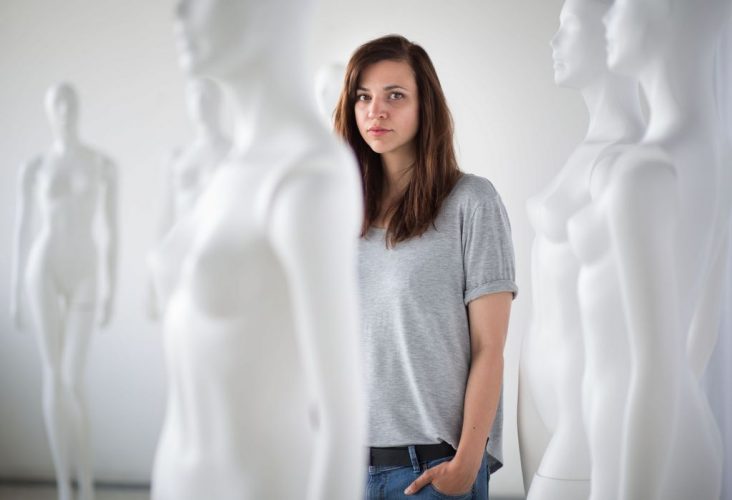
Eggomania by Jelena Proković/Slovenia
Jelena Proković found inspiration for her collection in the age-old traditions of Bela Krajina, a region in the south of Slovenia. It was Bela Krajina folk costume with its clear form, simple ornaments and the dominating white that captivated her imagination. The “leitmotiv” through which she visualised her collection comes from the patterns adorning traditional Easter eggs called pisanice or pisanke, a feature so defining for Bela Krajina that it comes second to none. The Eggomania collection is her personal interpretation of Bela Krajina’s ethnographic heritage through fashion.
The collection comes in black and white with a hint of red, which stands out in embroidery and ornaments, thus consistently adhering to the basic graphic elements that define the folk art and culture of Bela Krajina. At the same time this colour combination, characteristic also for avant-garde painting, distinctly reflects Jelena Proković’s design signature.
Her deconstructionist style draws from modernism and avant-garde, which in her collections frequently evolve into Gothic, futuristic, dystopian and even pseudo-militarist urban aesthetic. The collection is complete with headscarves as arather radical reinterpretation of traditional women’s headdresses characteristic of Bela Krajina, and original jewellery such as necklaces, earrings and fasteners.
Provocatively titled Eggomania, the collection carries two connotations. It can be understood as a result of the author’s fascination with the universal, civilizational, omnipresent symbolism of the egg. But it also references the affirmation of an uncompromising artistic stance and individuality. In another word – ego.
About Jelena Proković
Jelena Proković studied at the Faculty of Applied Arts and Design in Belgrade, where she graduated in 2015 in costume design and contemporary clothing culture.
As early as in 1992 she and her sister Svetlana launched their own brand JSP (Jelena & Svetlana Proković) and presented their first collection to the public. With its specific aesthetic and boldness the fashion brand JSP made a key contribution to the formation and development of the visual identity of the urban subculture in the Serbian capital.
The sisters’ collective has received a number of awards, among them BazART for the best fashion show at Belgrade Fashion week 2004, 2007 and 2010. In 2015, Jelena Proković received the Elle Style Award in Ljubljana for the best fashion designer as well as numerous awards for her costume designs, including the most prestigious Slovenian theatre award – Borštnik Award – in 2016. Her body of work spans more than 80 costume designs for theatre and film.
Like the JSP brand, Jelena Proković employs a distinctly avant-garde, modernist and deconstructivist approach to design. Her clothes and costumes are often characterised by aggressive, futuristic, even dystopic and militarist undertones that she offsets with sensuality and femininity.
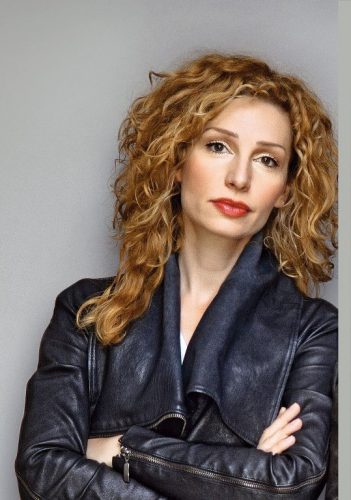
Exhibition
The goal of the Transformations project is to arouse interest in Slavic cultural heritage and to bring this heritage closer to the general public. Cultural heritage of five Slavic countries (Slovenia, Serbia, Russia, Slovakia and Bulgaria) came to life before our eyes, shining through different elements. The clothes and collections were inspired by different stories told by cultural heritage. The authors’ imagination was sparked by different historic periods. Their collections feature original garments, design sketches and photographs of the studio performance.
- Expert Advisor: Jožica Brodarič
- Fashion Photos: Peter Giodani
- Makeup Artist: Vanja Djuran
- Hair Stylist: Tomaž Turk
Highlights
On show at the Ljubljana City Hall
BigSEE Award for Bozhilov
Transformations fashion platform

NEWS

The project Transformations continues
The Forum of Slavic Cultures (FSK) remains committed to its ongoing project, “Transformations: FROM the Slavic Clothing Tradition TO Contemporary Designs”, as the initiative continues to gain momentum. In a recent development, talented designers from Poland, the Czech Republic, Croatia, North Macedonia, and Montenegro had their collections captured through a photoshoot held in May 2023. In September we are planning a comprehensive presentation of the project at the Museum of Applied Art in Belgrade.
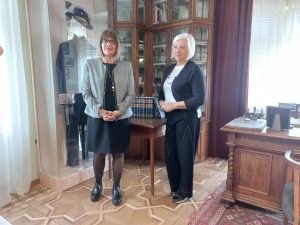
Maja Gojković, FSK Board President, Joins Work Meeting at Villa Zlatica
During a working meeting held at Villa Zlatica, the Deputy Prime Minister and Minister of Culture of the Republic of Serbia, as well as the President of the FSK Board, Maja Gojković, and the Director of the Forum of Slavic Cultures, Andreja Rihter, engaged in a productive discussion on the importance of implementing the FSK program designed to promote the rich cultural heritage of the Slavic countries.
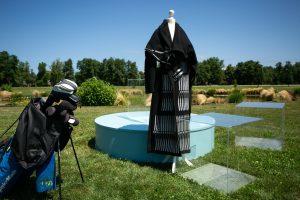
Eggomania on the Golf Course in Moravske Toplice
The Eggomania collection, designed by Slovenian fashion designer Jelena Proković for FSK, made a great impression at the international golf tournament in Moravske Toplice.
STORY
Transformations are the first in the series of the Forum of Slavic Cultures’ activities to set up a long-term fashion platform for showcasing the creativity of Slavic countries, which has been winning its way to the runways of the world’s fashion capitals with its specific sensibility.
In the first phase which began in 2018 the project brought together selected fashion designers from Slovenia, Serbia, Russia, Bulgaria and Slovakia.
Under the baton of curator Jožica Brodarič fashion designers created unique collections inspired by the rich cultural heritage of their respective countries and interpreted it with their original vision in the global context of contemporary fashion design.

